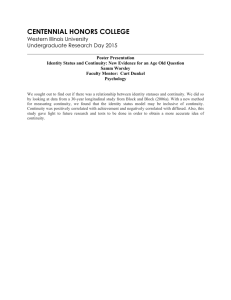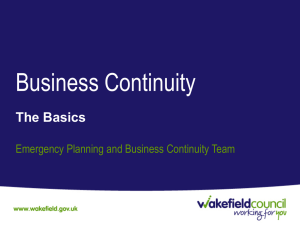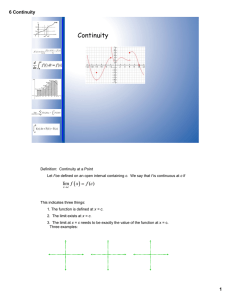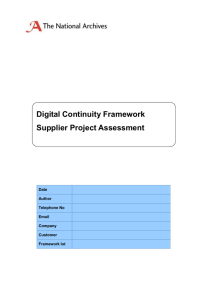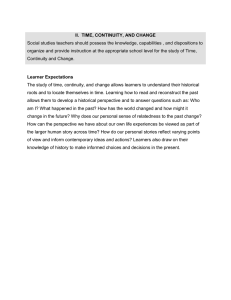A digital continuity glossary
advertisement
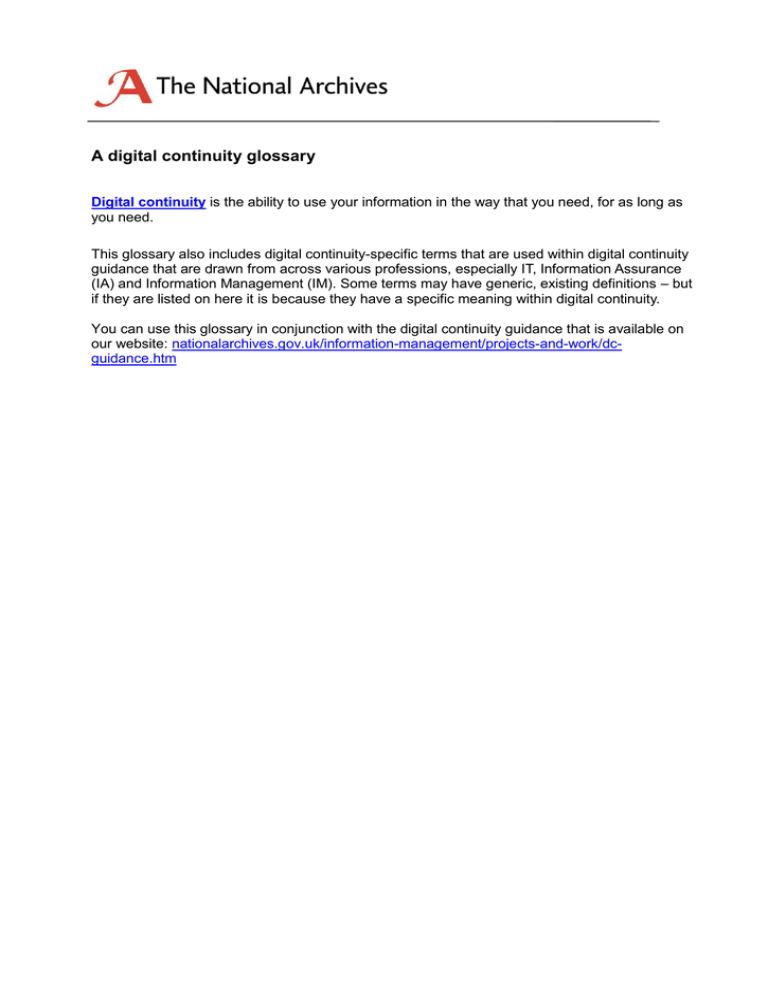
A digital continuity glossary Digital continuity is the ability to use your information in the way that you need, for as long as you need. This glossary also includes digital continuity-specific terms that are used within digital continuity guidance that are drawn from across various professions, especially IT, Information Assurance (IA) and Information Management (IM). Some terms may have generic, existing definitions – but if they are listed on here it is because they have a specific meaning within digital continuity. You can use this glossary in conjunction with the digital continuity guidance that is available on our website: nationalarchives.gov.uk/information-management/projects-and-work/dcguidance.htm The glossary Jump to: A B C D E F G H I J K L M N O P Q R S T U V W X Y Z TERM A Asset Availability (of an information asset) DEFINITION Any resource or capability. Assets of a service provider include anything that could contribute to the delivery of a service. Assets can be one of the following types: management, organisation, process, knowledge, people, information, applications, infrastructure, and financial capital. See information asset also. Ensuring information assets can be found, opened and worked with in the way required. This extends the traditional understanding of availability as having hardware, software and systems available and working when needed, to one of full availability of the information in the way you need to use it. This means having the right processes and technology available for the way you want to work with the information. Back to top B Business continuity Business needs/ requirements Ensuring an organisation’s critical functions remain available over time and through change. Ensuring the digital continuity of critical business information should be one aspect of business continuity planning. The required purpose of an information asset. A combination of why the asset is held, what it needs to be used for, how it will be used and the value that this will bring to the organisation. Back to top C Characterisation The extraction of significant properties of a digital object – e.g. the format of a file, dimensions of an image, the number of words in a document. Completeness (of information assets) Ensuring that neither the content nor the context of an information asset is missing or degraded (either intentionally or accidentally) in any way. Configuration Item (CI) Any individual component that is required to deliver an IT service. CIs can vary widely in size and type, though typically include IT services, IT systems, hardware, software, documentation, supporting staff and buildings. Configuration management The process responsible for ensuring an IT service’s performance and functionality remain consistent with the requirements and design for that system throughout its lifespan. It maintains information about Configuration Items required to deliver an IT Service, including the relationships between them. (Information) Content The human or machine readable representation of the information stored in a file, e.g. words, images, sounds, figures. Layout, design attributes, colours etc may be considered to be an element of content. (Information) Context The information about information or an information asset that enables us to understand what it is about. Metadata, location in a file plan, protective marking and associated records are all examples of context. Back to top D Digital archiving Storing, preserving and providing access to electronic government records – everything from emails and web pages to multimedia formats. Digital continuity The ability to use your information in the way you need, for as long as you need. Digital Continuity Framework A catalogue of tools and services to support the management of digital continuity issues and risks, which public sector organisations can procure through Buying Solutions. Digital continuity requirements The completeness and availability your information assets must have in order to deliver your usability requirements. Digital obsolescence The inability to read a digital object because the software, hardware or systems required are no longer available or are no longer supported. Digital obsolescence may result from the supplier no longer trading, having ceased support or only supporting newer versions of its products. Digital preservation The long-term archival management of digital information assets selected for their historical value, once they have passed out of business ownership. Back to top E e-Discovery Electronic Document and Records Management System (EDRMS) The evidential retrieval of relevant information from a large body of unstructured data (e.g. documents and emails). An e-discovery process goes beyond simple searching, to allow relationships between the data to be explored and refined. E-discovery is typically used in support of legal proceedings, but it has wider applicability in digital information management. A system designed to manage electronic content, documents and records. EDRMS should support creation and capture, organisation and curating of the content, collaboration and version control, and output. Content is usually unstructured or semi-structured. Back to top F File characterisation The process of understanding significant properties of a file. Examples of significant properties are: the file format type and version (for any file), character encoding (for text files), dimensions (for image files), or number of pages (for documents). Where only the format type and version are identified, this is also known as file format identification. File format The organisation of binary data within an individual file. File formats are sometimes indicated by the file name extension, if present (e.g. .doc for some Word documents), but this is not always reliable. File format identification The process of understanding both the format type and version of a file. See also file characterisation. Back to top G Back to top H Back to top I Incident reporting The process by which the occurrence of an issue is formally reported. Information asset An information asset is a body of information, defined and managed as a single unit so it can be understood, shared, protected and exploited effectively. Information assets have recognisable and manageable value, risk, content and lifecycles. Information Asset Owner (IAO) Information Asset Owner is a role assigned to a senior member of staff by the SIRO to ensure specific information assets are handled and managed appropriately. This means making sure information assets are properly protected against risk and that their value to the organisation is fully recognised. Information Asset Register (IAR) A mechanism for recording your information assets, which should be used for documenting what you know about your information assets, business needs and technical environment. In practice, it may consist of a number of separate registers documenting particular aspects of your digital information and its environment. Information assurance The practice of managing information risks. See also information risk management. The key elements of information assurance are: confidentiality, integrity, authenticity, availability and nonrepudiation. Information Assurance Maturity Model (IAMM) The National Information Assurance Strategy requires government to ensure its information is protected and available as needed and the supporting IAMM includes loss of digital continuity as an information risk to be managed. This model includes five clearly defined stages of information assurance maturity within an organisation. The model is aimed at SIROs and designed to deliver key information assurance goals of embedding information and records management culture, best practice information assurance and effective compliance. Information Technology Infrastructure Library (ITIL) A set of consistent and comprehensive documentation of best practice for IT Service Management released as a series of guidance books. Back to top J Back to top K Back to top L Back to top M Machinery of Government (MoG) Metadata The structures and processes of government. It is often referred to in the context of change, i.e. the creation of a new department or the merging of existing departments. Data about data. Metadata describes various attributes of a file. For example, technical metadata will describe file format, size, creation date etc; descriptive metadata will describe title, author, classification etc. Limited technical and descriptive metadata may be attached to the file itself. More detailed metadata is often added through an information management system, such as an EDRMS. Back to top N Back to top O Back to top P Provenance The associated understanding of an information asset’s origins, custody and ownership, which enables the user to understand its source and integrity (i.e. the user can trust the information they have). Back to top Q Back to top R Back to top S Senior Information Risk Owner (SIRO) Senior Responsible Owner (SRO) The SIRO is an executive accountable for information risks and leads the department’s response. The SIRO ensures the risk to digital continuity is being managed efficiently and effectively and ensures there is a multi-disciplinary approach to information risk management in an organisation. The SIRO appoints the SRO to manage digital continuity. The Senior Responsible Owner (SRO) is the individual with overall responsibility for ensuring digital continuity in an organisation. Back to top T Technical environment The systems on which information assets are stored, the hardware and software they rely on. Back to top U Usability requirements The requirements for how each piece of information or information asset needs to be found, opened, worked with, understood and trusted. Your usability requirements can then be used to define the completeness and availability required to maintain continuity. Back to top V Back to top W Back to top X Back to top Y Back to top Z

